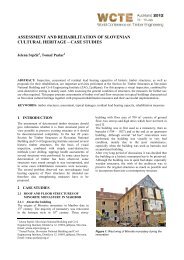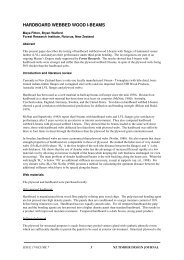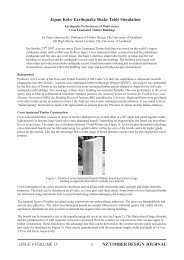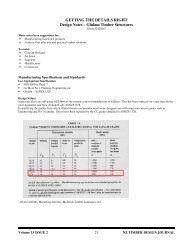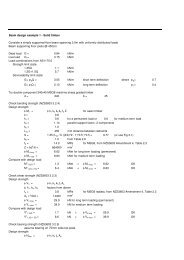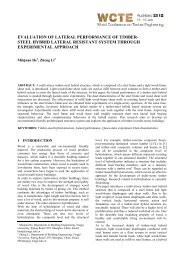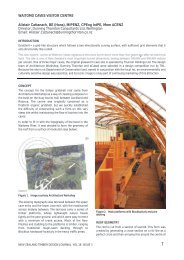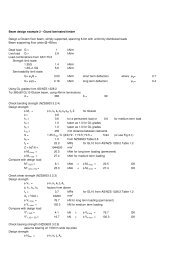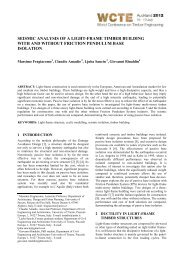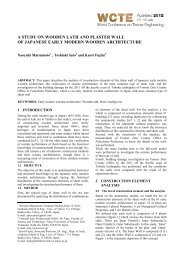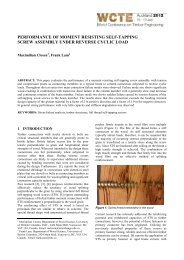00350 Cecilia Alonso - Timber Design Society
00350 Cecilia Alonso - Timber Design Society
00350 Cecilia Alonso - Timber Design Society
Create successful ePaper yourself
Turn your PDF publications into a flip-book with our unique Google optimized e-Paper software.
PERFORMANCE OF A MECHANICALLY LAMINATED<br />
TIMBER ARCHED SUSPENSION BRIDGE<br />
<strong>Cecilia</strong> <strong>Alonso</strong> 1 , Abdy Kermani 2<br />
ABSTRACT<br />
The first constructed bridges were probably made of<br />
wood. When sympathetically designed, timber bridges<br />
are often easy to construct, economical, aesthetically<br />
pleasing and have a long life expectancy. In order to<br />
enhance its environmental advantages, specified timber<br />
must be locally sourced from sustainably managed<br />
forests. In the UK, with low-grade home-grown<br />
softwood and no established glue-lamination industry,<br />
mechanical lamination can offer a cost competitive and<br />
structurally efficient solution to overcome the long-span<br />
and design requirements of pedestrian and vehicle bridge<br />
construction. 12<br />
Stress-Laminated <strong>Timber</strong> (SLT) is a relatively new<br />
technique mainly used in bridge decks in which<br />
rectangular sawn timber laminates are post-tensioned<br />
transversely with high-strength steel rods. The<br />
compressive pressure generates friction forces between<br />
the laminates, creating a solid wood plate with<br />
orthotropic characteristics. Therefore, the planks do not<br />
have to be continuous over the whole bridge span. Butt<br />
joints can be introduced, allowing the deck to be<br />
constructed using short lengths of timber. In addition,<br />
SLT decks with butt joints may be cambered to offset the<br />
dead-load deflection and the additional vertical creep.<br />
However, it has been found that the application of flat<br />
slab-type stress-laminated decks is limited to bridges of<br />
6 to 9m spans using normal timber sizes up to 250mm.<br />
Composite pre-stressed T-beams and box section decks<br />
have been developed in order to extend the possibilities<br />
of SLT, but these systems are not suitable for the UK<br />
due to the wet weather or the requirements for<br />
construction of bespoke glulam members.<br />
1 <strong>Cecilia</strong> <strong>Alonso</strong>, Napier University, 10 Colinton Road,<br />
Edinburgh EH10 5DT, UK. Email: cecilia.alonso@yahoo.es<br />
2 Abdy Kermani, Professor and Director of Centre for <strong>Timber</strong><br />
Engineering (CTE), Napier University, 10 Colinton Road,<br />
Edinburgh EH10 5DT, UK. Email: a.kermani@napier.ac.uk<br />
In order to overcome the limitations of the flat deck<br />
stress-laminated systems in the UK, the performance<br />
characteristics of SLT bridges, in an arched form<br />
developed at Edinburgh Napier University, were recently<br />
studied. The extensive research revealed that the<br />
utilisation of timber in an arching action where timber<br />
predominantly acts in compression and end-bearing<br />
rather than in bending, drastically improves the strength<br />
and stiffness of the bridge. But as the benefits of the<br />
arching action increase with the rise to span ratio, the<br />
ease of access over the deck due to increase in slope<br />
becomes a limiting design criterion.<br />
This research has focused on the development and<br />
examination of the structural performance of a flat SLT<br />
bridge deck suspended from two screw-laminated timber<br />
arches. A mechanically laminated composite timber<br />
arched bridge with suspended flat deck was designed as<br />
a half-scale of a 12m span bridge for pedestrian use, and<br />
was subjected to a series of analytical and experimental<br />
investigations under static loading conditions.<br />
20mm thick off-cuts of low grade, UK grown Sitka<br />
spruce timber, was used for this purpose. Screwed<br />
lamination of short planks of timber was selected to form<br />
the supporting arches. The laminates were cut at a<br />
predetermined angle so that compression is mainly<br />
transferred through end-bearing at the butt joints whilst<br />
the fasteners transmit shear forces between the<br />
laminates.<br />
The half-scale of a 12m span pedestrian bridge<br />
comprised a 6m span, 540mm wide 100mm deep flat<br />
SLT deck suspended from two 110mm wide x150mm<br />
deep screwed laminated arches all using 20mm thick offcuts<br />
of Sitka spruce timber. The horizontal thrust was<br />
carried by steel tie bars, fixed to steel bearing plates at<br />
either ends of each arch. Their elasticity was designed to<br />
simulate the horizontal settlement of the supports. The<br />
bridge was subjected to a series of four-point and<br />
eccentric line loads up to approximately 2.75 times the<br />
design load (5kN/m 2 ) and the load-deformation<br />
characteristics were monitored and recorded.
edistribute loads around a localised failure, laminated<br />
timber showed an outstanding post-critical load capacity,<br />
even after strength failure had occurred.<br />
A finite element model was developed using a<br />
commercially available analysis programme. The close<br />
agreement between the analytical and experimental<br />
results demonstrated that the structural behaviour of the<br />
laminated timber structures can be accurately predicted<br />
using linear elastic analysis.<br />
Figure 1: Maximum measured vertical deflection of the<br />
deck under a line load at various positions.<br />
The results showed that the timber bridge behaved<br />
elastically well beyond the design load. The maximum<br />
deflection of the deck under the design load<br />
corresponded to only a 1/1000 of the span for the<br />
symmetric loading and 1/850 for the asymmetric<br />
loading.<br />
The bridge was then loaded to failure under a quarterpoint<br />
loading. The bridge supported an eccentric load of<br />
50kN until the collapse of a secondary member. After<br />
replacement of the damaged component, the model was<br />
again loaded under a four-point loading up to 50kN. This<br />
last test confirmed the superior recovery capacity of the<br />
laminated timber bridge after being subjected to loads<br />
close to failure. Additionally, it was found that the<br />
failure of the bridge under a symmetric loading would be<br />
governed by out-of-plane buckling of the laminated<br />
arches.<br />
The study, carried out at the UK’s Centre for <strong>Timber</strong><br />
Engineering at Edinburgh Napier University successfully<br />
demonstrated that large span stiff and strong structures<br />
can be constructed by means of short lengths of low<br />
quality timber. In comparison with glued-lamination<br />
methods, typical for these structures, mechanical<br />
lamination does not require expensive and nonenvironmentally<br />
friendly gluing techniques, and hence<br />
provides low-cost construction using locally available<br />
timber and semi-skilled labour. Maintenance and<br />
repairing of these structural systems could simply be<br />
reduced to the replacement of the damaged laminate(s),<br />
as end of life disposal and recycling processes are<br />
enhanced. Individual laminates can be easily transported<br />
to the site for the construction of large span bridges in<br />
areas of difficult access.<br />
Once the design and production techniques become well<br />
established, the construction of medium to long span<br />
bridges using mechanically laminated timber in public<br />
paths and roads would further enhance confidence in the<br />
use of locally produced timber as an economical and<br />
sustainable material.<br />
Due to the ductility of the structural system, the<br />
dispersion of wood natural defects and the ability to<br />
Figure 2: Deformed shape of the physical and computational model subjected to a quarter-point loading.



